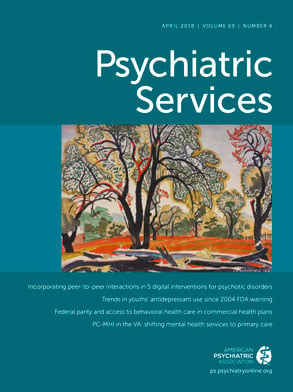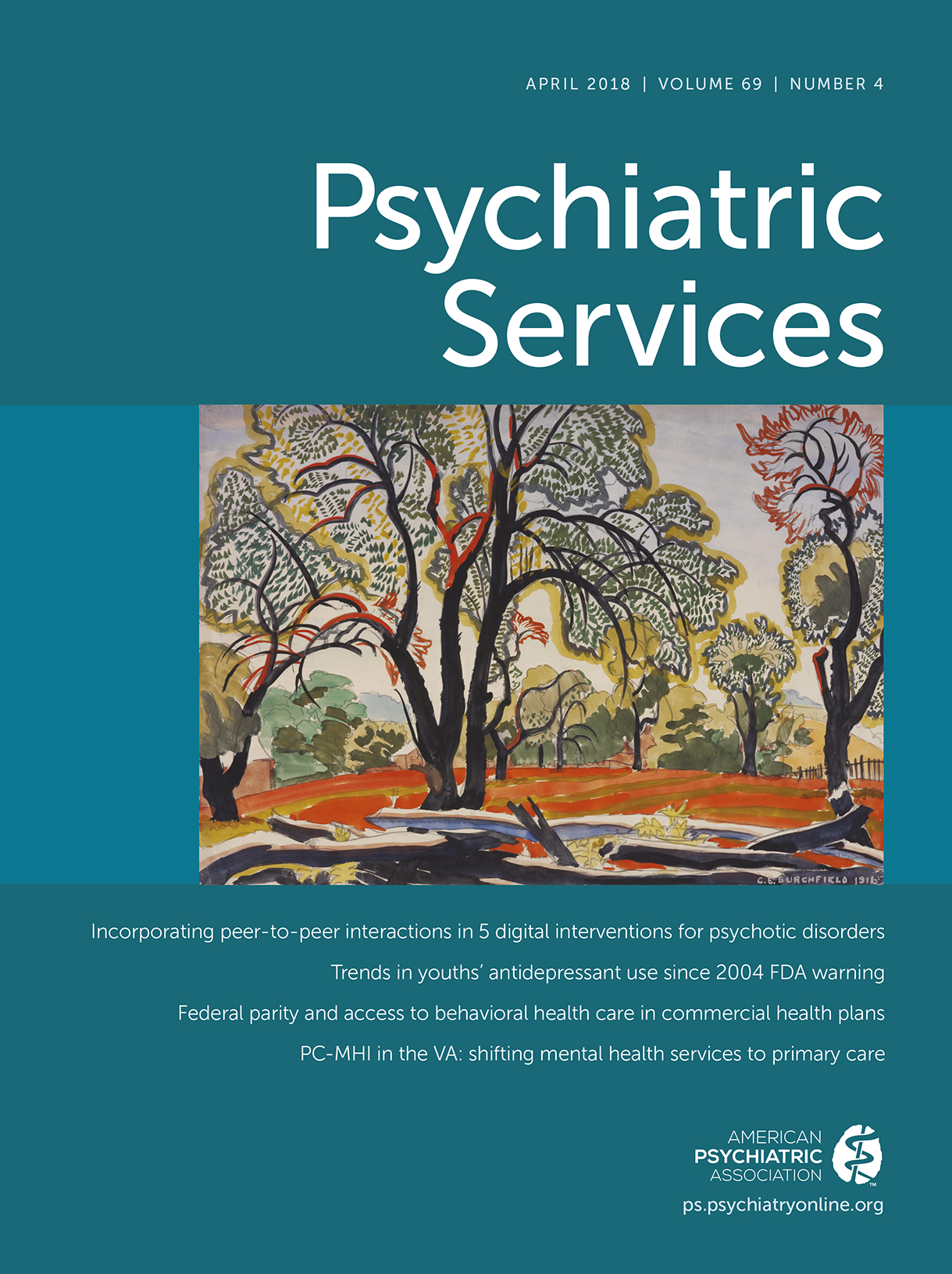Clinical depression and related mood disorders are strongly associated with significant disruption in work, education, relationships, and social roles (
1). According to the World Health Organization, depression is the leading cause of disability worldwide, affecting an estimated 350 million people (
2). Depression onset increases dramatically during the middle and high school years, with nationally representative past-year prevalence rates for adolescents estimated at 7.5% (
3). Among adolescents, depression adversely affects developmental trajectories and is strongly associated with functional impairment, recurrent depression later in adulthood, and comorbid mental disorders. Depression at this age is also linked with alcohol involvement (
4), smoking (
5), drug use (
6), problems with peers and parents, and poorer academic performance (
7), all of which are risk variables for suicidal ideation, suicide attempts, and death by suicide (
8,
9).
Mental health professionals have targeted adolescent depression through school initiatives, given that youths spend more time in school than in any other formal institutional structure and because school plays a key role in adolescent development (
10,
11). One such initiative is the Peer-to-Peer Depression Awareness Program (P2P), which was developed by the University of Michigan Depression Center (UMDC) and the Ann Arbor Public Schools (AAPS). The P2P program, which is built on a universal, school-based depression awareness approach, educates students about depression and related illnesses and supports them in finding creative ways to convey this knowledge to their peers in order to improve the school climate around mental health, direct students to mental health resources, and encourage help-seeking behavior. To reach incoming students each year and have an ongoing impact in the school and broader community, the program is designed to maintain a continuous presence in school systems.
In this report, we describe the P2P program and provide outcome data from the 10 high schools that were involved during the 2015–2016 academic year, the most recent year for which data are available.
Methods
To recruit P2P team members, volunteer adult mentors within each school consulted with school staff (principals, counselors, and teachers) to identify student “champions” from all grade levels. P2P members from schools with established programs aided with recruitment. Moreover, at some schools, team members were recruited in peer mentorship classes and students who independently expressed interest in being on a P2P team were asked to complete a formal application. The P2P team members did not provide mental health counseling of any kind for their peers or give mental health advice. Rather, they were “peer advocates” who helped create a supportive environment in their schools and could connect their peers with appropriate information and treatment resources. Teachers at each high school were asked to assist with recruitment of the non–P2P student sample, which was comprised of students from the general student population. Schools were advised to offer mental health training to staff before program implementation to prepare them to provide ongoing social and emotional support for students. The UMDC worked with each school to find suitable training if needed.
P2P team members first attended a six-hour, one-day kickoff conference that covered evidence-based information about mental health, coping skills, and peer support resources, as well as information about social marketing strategies and active listening skills. Attendees were provided a menu of options for potential campaign formats and were given specific messages to incorporate. After the initial training, each P2P team developed a schoolwide public awareness campaign. The P2P teams submitted project proposals to their mentors and the UMDC staff to ensure that each campaign included accurate, safe, and effective messaging. Projects were implemented from January to May of the following year. All activities, such as video scripts, posters, and lesson plans, were reviewed by UMDC staff prior to implementation. In May, all student teams attended the end-of-year celebration conference and delivered presentations detailing their campaigns and lessons learned to other participating schools. Teams also submitted a final implementation report.
Under the guidance of the University of Michigan Institute for Social Research, the P2P Depression Awareness Questionnaire was adapted from a previous version. The questionnaire was organized into seven major domains: demographic characteristics (four items), helping others with a mental illness (three items), helping yourself (two items), depression knowledge (12 items), depression help seeking (12 items), school environment and stigma (11 items), and P2P program visibility (five items).
Two samples of students were selected from each high school. The first sample was comprised of students who participated directly in the creation and implementation of the P2P projects (referred to as “P2P team members”). The second sample was comprised of students who did not create the P2P projects but who were exposed to awareness materials (referred to as “non-P2P students”). The P2P mentor was responsible for setting up dates for P2P members to complete the questionnaire and for communicating with classroom teachers about the best times for non-P2P students to complete the questionnaire.
Prior to the training conference, all P2P team members completed a baseline questionnaire. Before campaign implementation, samples of non-P2P students from each school completed the same questionnaire. Participants were assigned a confidential ID number, and the questionnaire instructions clearly explained the anonymous nature of the study as well as the voluntary nature of participation. In May, within one week of the end-of-year celebration conference, all P2P student team members and non-P2P students were asked to complete the posttest questionnaire. The five items related to P2P program visibility appeared only on the posttest questionnaire. [Details about the P2P program, including a sample project timeline, and a more detailed description of study methods and limitations and the psychometric properties of the survey are available in an online supplement to this article.]
All analyses were conducted with the SPSS statistical software package, version 22.0 (
12). Descriptive analyses focused on estimating the overall effects of the P2P program by assessing changes from baseline to posttest among P2P team members and non-P2P students. Results are based on baseline and posttest pairwise comparisons. Baseline and posttest means, standard deviations, and percentages are reported. The alpha level was set at .05.
Results
In the 2015–2016 academic year, there were 121 P2P team members across 10 schools. Teams ranged from a minimum of five students to a maximum of 30 students. Overall, 878 students completed questionnaires, including 49 team members and a convenience sample of 829 non-P2P students from the 10 participating high schools.
Each school created an awareness campaign consisting of three to 10 components. The average number of activities implemented among 10 schools was 5.2. The majority of campaigns used a combination of content and promotional activities to share in-depth information and maximize reach. The most frequent activities included school assemblies, displaying material around the school (such as posters and flyers), and promotional giveaways (such as wristbands and stress balls). One school, for instance, made “stress buster” relaxation bags for each homeroom classroom. Another school had a “referral box,” in which students could deposit a form for describing concerns about a classmate.
Table 1 displays complete pre- and posttest results for P2P team members and non-P2P students from participating schools. Pretest scores of participants who did not complete the posttest were dropped. At posttest, P2P team members showed statistically significant improvements in confidence in identifying and helping others with depression and in comfort speaking with their peers about mental health issues. They also were significantly more likely to believe other students would try to help a new student with depression. Moreover, at posttest, non-P2P students showed a statistically significant increase in the likelihood that they would ask for help if they had symptoms of depression for more than two weeks. They also showed a significant decrease in perceived embarrassment about being seen going into the school social worker’s or psychologist’s office and were more likely to consider seeking help from seven out of 12 sources. For the item related to school environment and stigma, six of 10 subitems showed statistically significant improvement. Non-P2P students were also significantly more comfortable discussing mental health issues with their peers after the intervention.
A sample of postcampaign scores were compared from non-P2P students according to responses to items about program visibility. All non-P2P students were potentially exposed to the general publicity campaign, with 71% of respondents stating that they were aware of the P2P group and activities and 33% of respondents proceeding to attend additional specialized programs. Postcampaign scores seem to show a dose-response relationship between greater involvement in P2P and improved scores [see online supplement].
Discussion
The P2P program is designed to create a school climate in which students feel comfortable talking about mental illnesses and understand that it is okay to ask for help if they need it. Following the intervention, students in participating schools were more knowledgeable about depression, more confident in their ability to identify and refer peers who may be struggling with depression, more willing to seek help for themselves if needed, and reported lower mental illness stigma in their school environment. The peer leaders served as positive role models and helped shape social norms and attitudes regarding mental disorders. Qualitative remarks also supported the program’s popularity and effectiveness. Given the early age of onset of depression (
8) and the critical importance of early detection and prevention of depressive disorders (
13), these findings are noteworthy.
Initiatives such as the P2P program that truly capitalize on youth voices and actively engage youth in program design or implementation are rare. [Some notable examples are described in the
online supplement]. According to Karcher et al. (
14), youth interventions should be voluntary and structured in order to increase intrinsic motivation and promote prosocial engagement with peers. A unique feature of our intervention is the structured yet adaptable nature of the program. Despite the use of external guidance from staff and specified student parameters, the P2P activities and delivery format were driven by the choices of the students.
Moreover, data suggest that the reach of the program was broad and that the program provided high school youths with meaningful opportunities for involvement. All five high schools in AAPS have participated in the P2P program since its inception, with an additional six high schools from neighboring districts also participating in the program and more schools joining each year. In addition, a number of positive changes in outcomes were fostered among the students who attended P2P program events and even among those who merely noticed mental health initiatives at school.
Moving forward, the P2P program has plans for expansion. UMDC staff has developed a manual for new mentors containing P2P program guidelines and will be creating web-based didactic resources in order to expand the program’s reach to additional geographic locations and stages of education.
Conclusions
Tapping into youth voices is a huge part of the success of the P2P program. The intervention increases depression literacy through the use of youth-designed and youth-implemented depression awareness and outreach activities, which may result in earlier detection of depression and in fewer depression sequelae. Positive outcomes were observed among both P2P student team members as well as non-P2P students who were exposed to the campaigns’ messages, demonstrating the program’s value as a universal prevention program.

